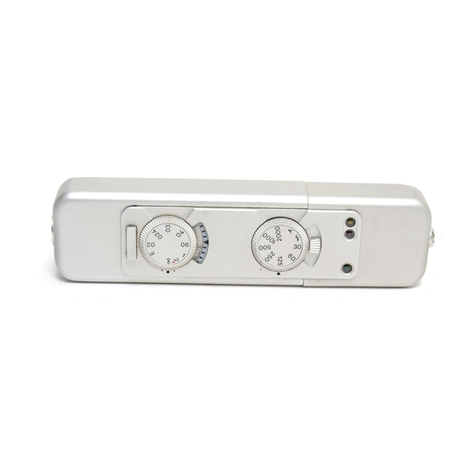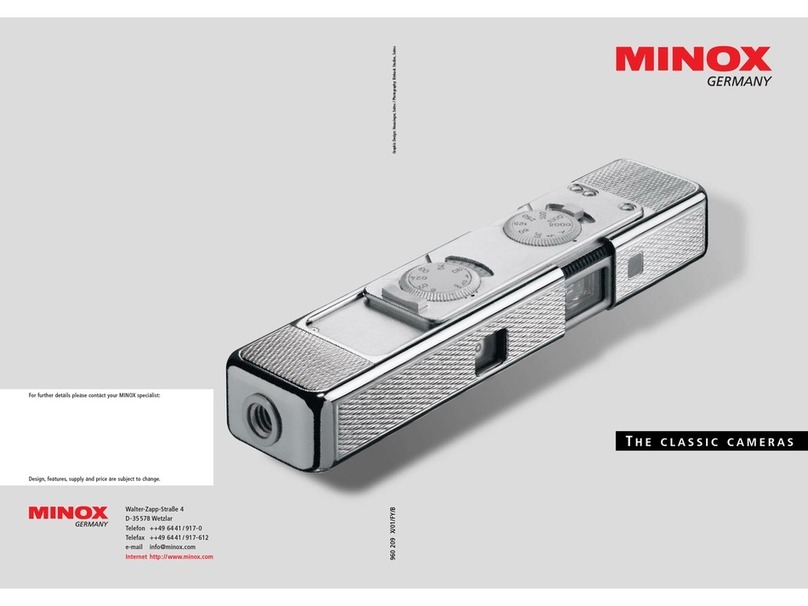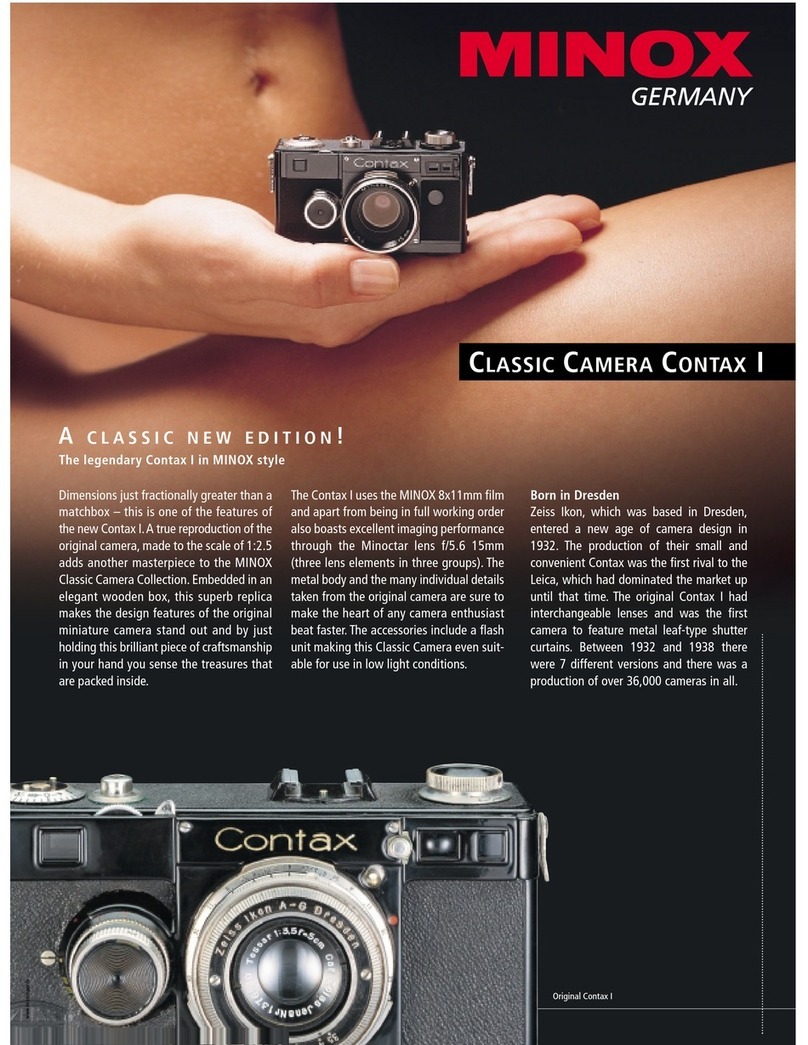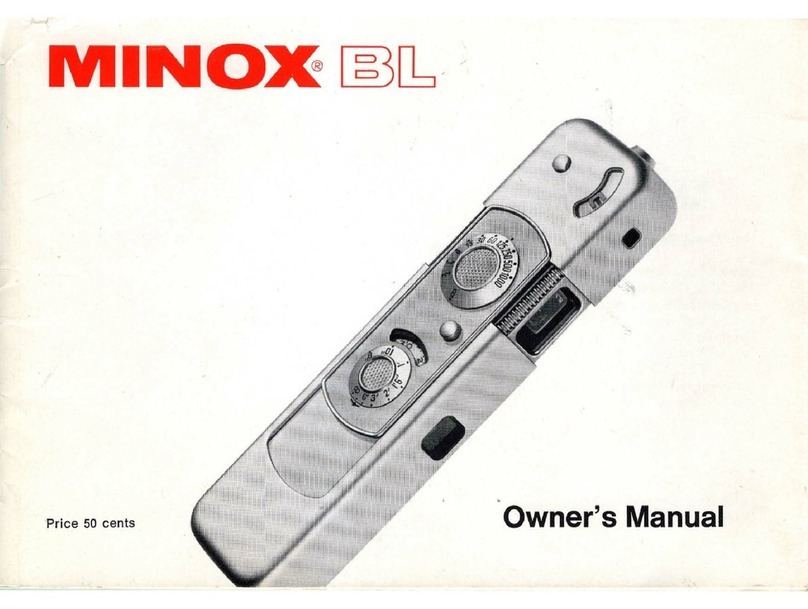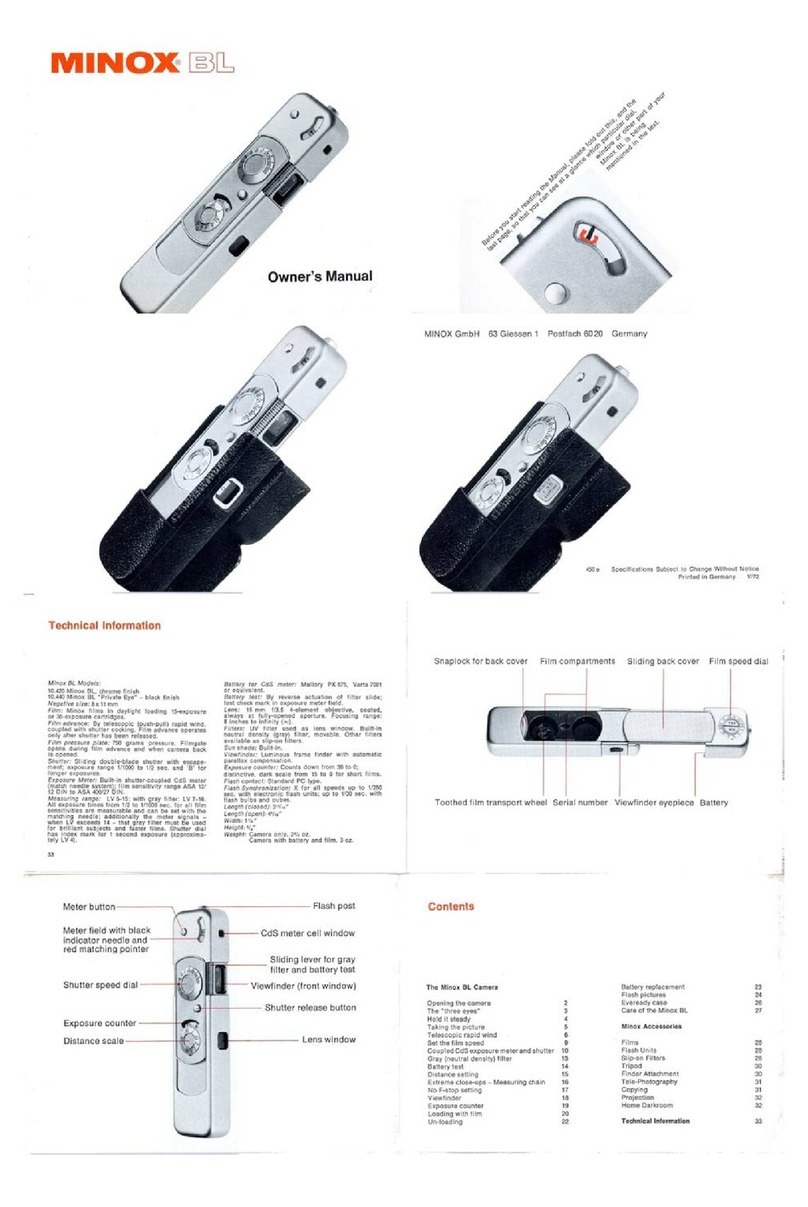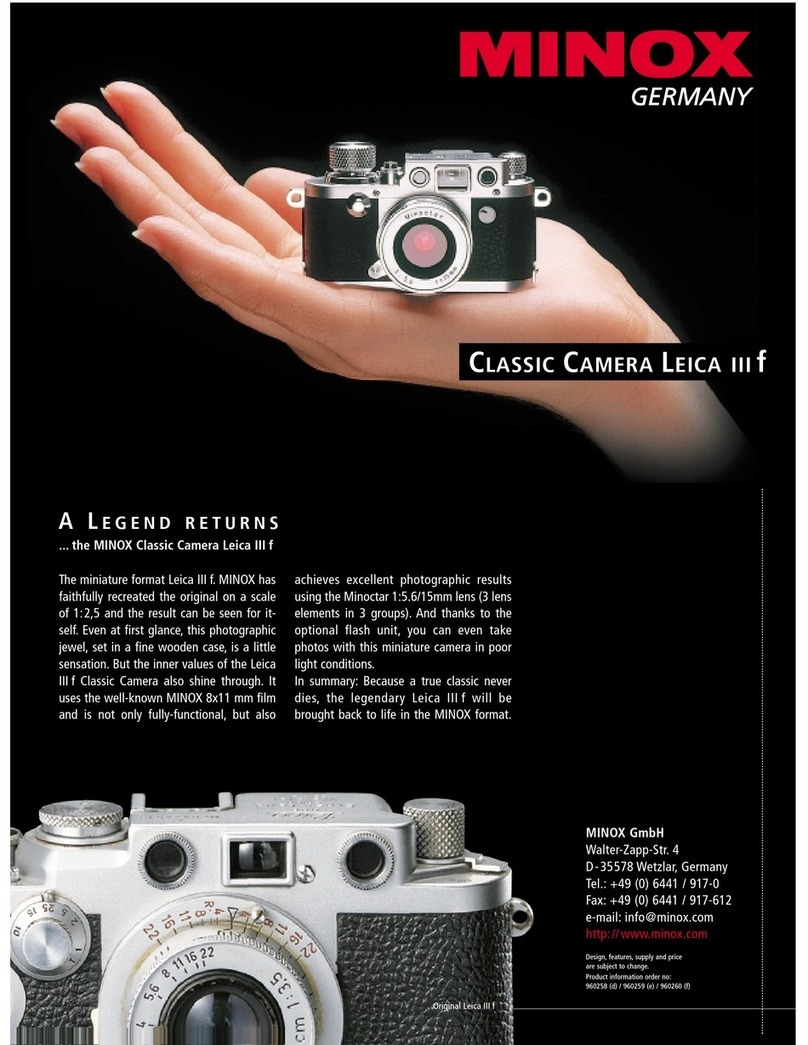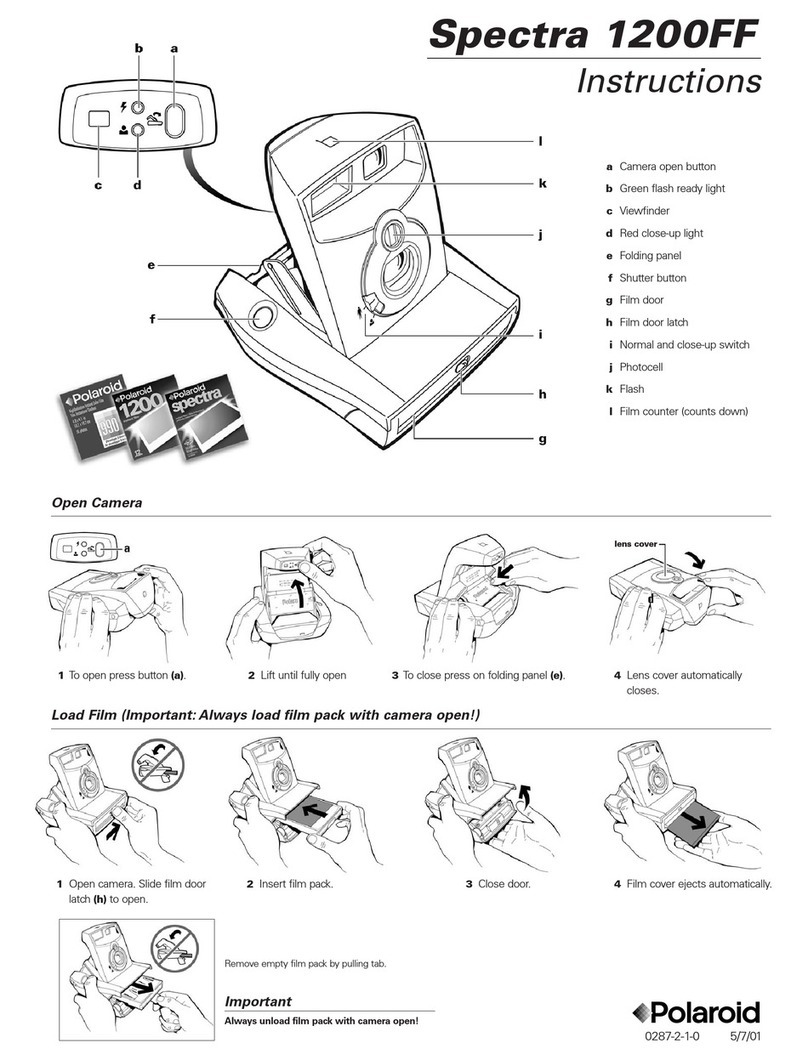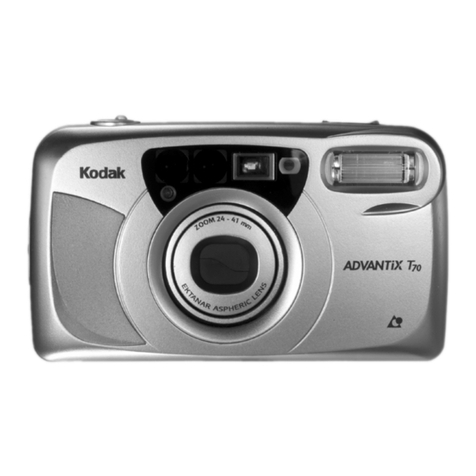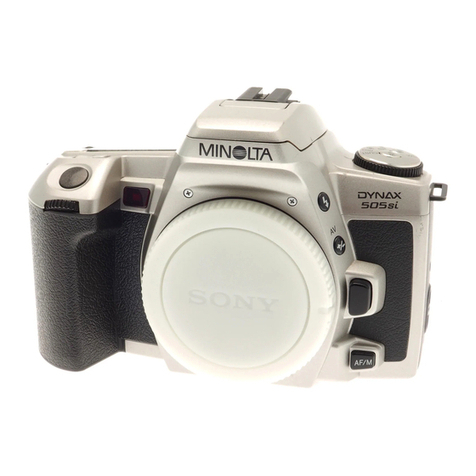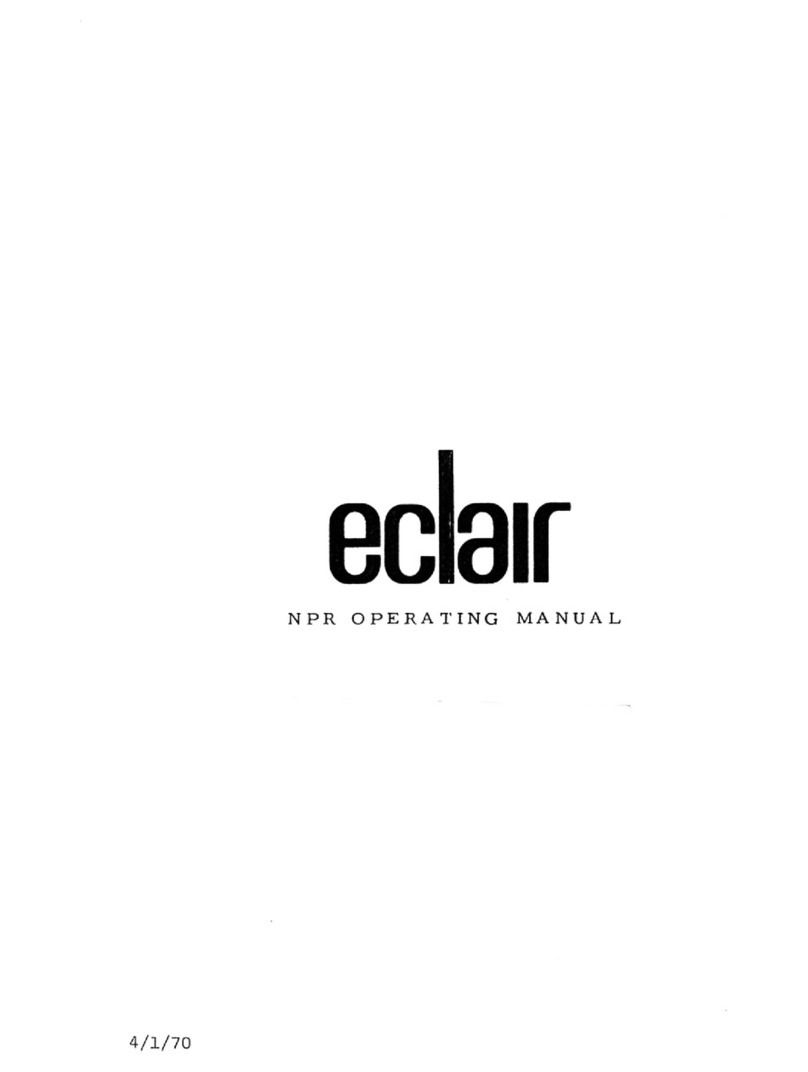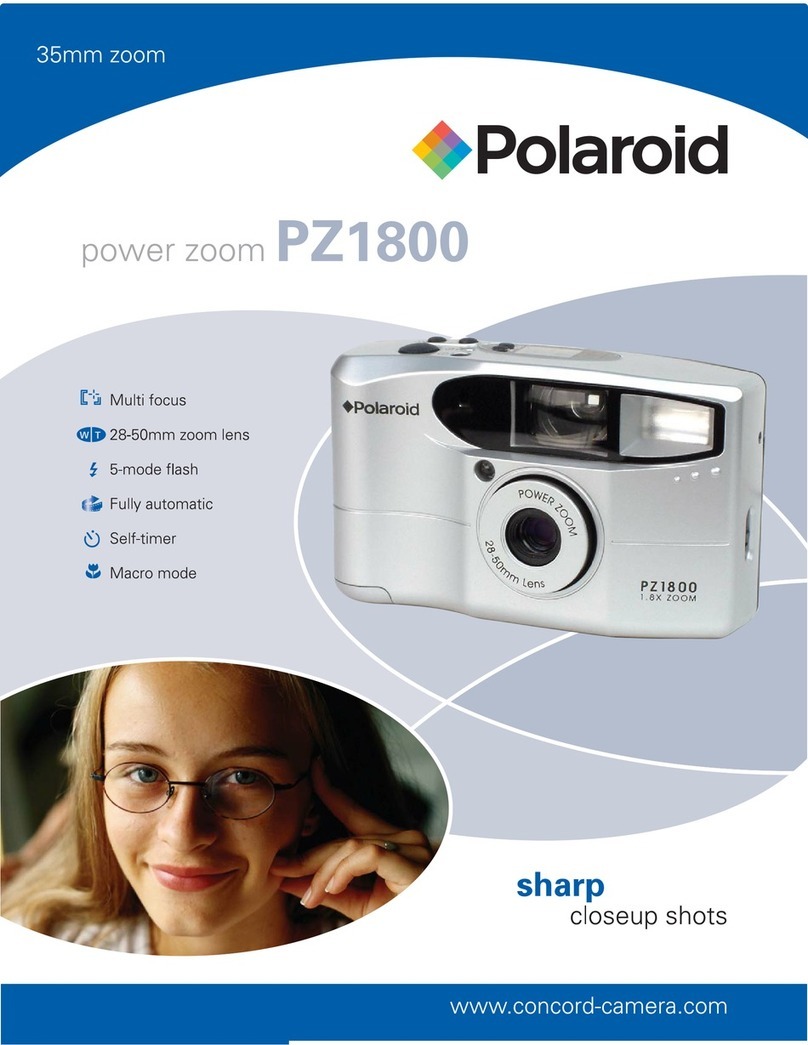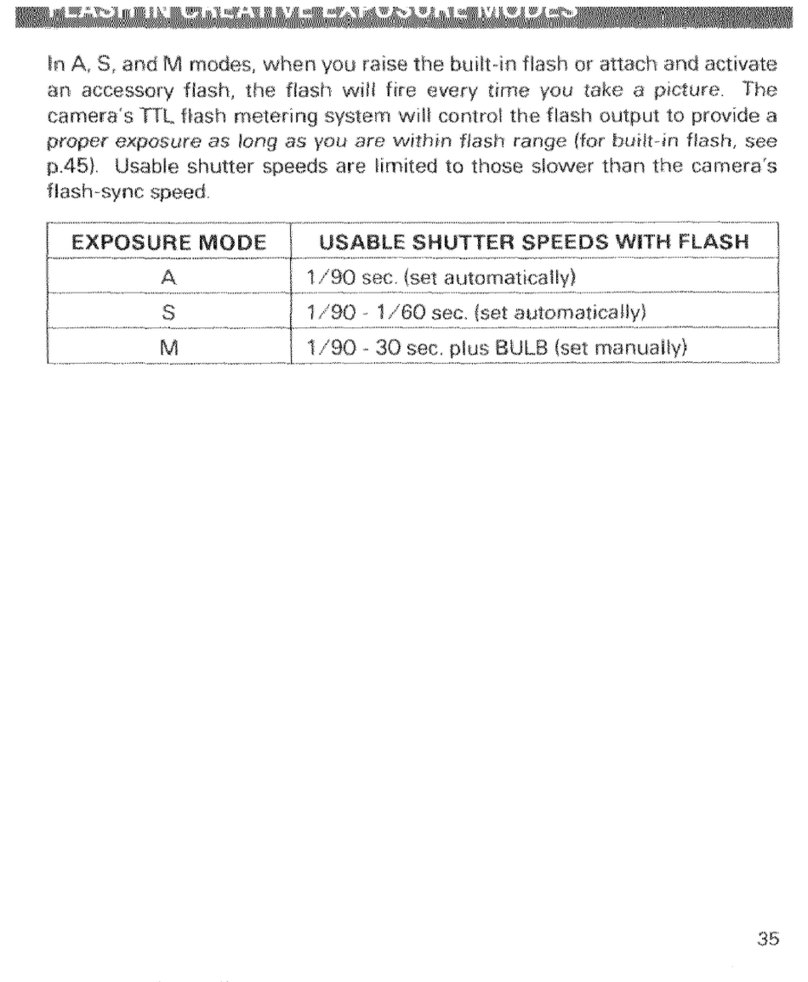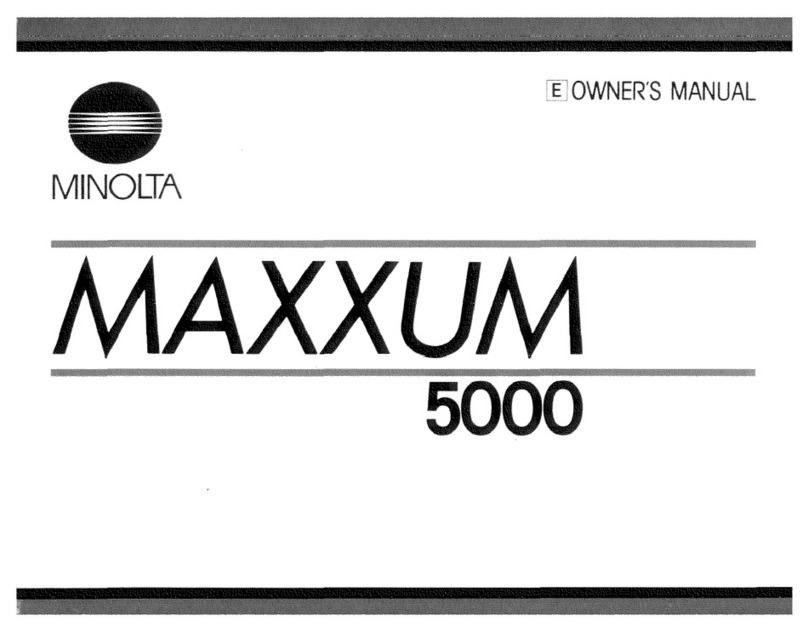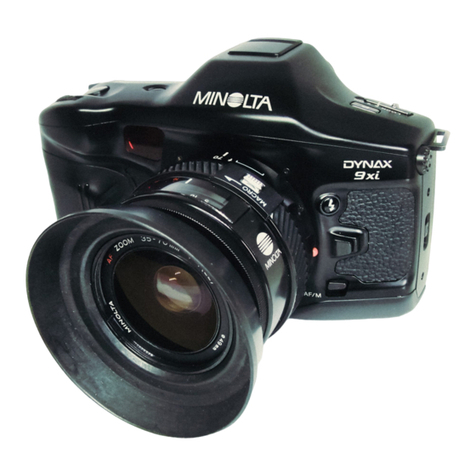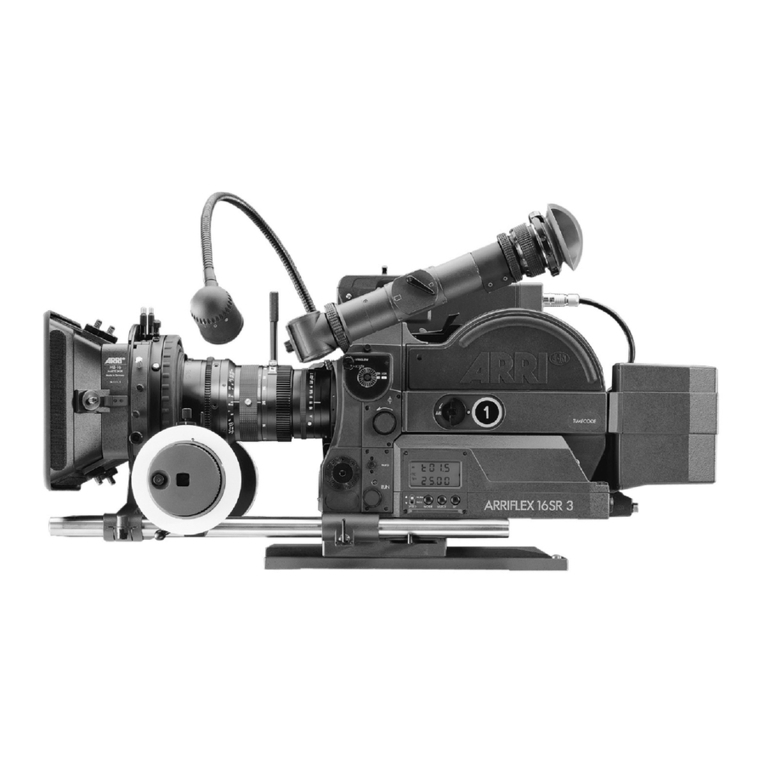Minox LX User manual

MINOX
LX
Owner's Manual

Inevitably you will find some technical terms
in
this booklet. So before you start reading the
Manual, fold out this
and
the last page. Then
you can see at a glance which particular dial,
window or other part of the Minox
LX
the text
refers to.

.--...J
IiiIiIIi
~
:::-
-----
---
Flash socket
Overexposure signal (red)
__
__
+
-,
Long time signal (yellow)
----
---1Ii
.e
IH
+--i
---
Battery check signal (green)
Meter cell (Silicon blue cell)
Check switch
---------
M"''''
J11
__________
Filter slide
Shutter speed dial
___
____
Hi
_______
Viewfinder window
Exposure counter_ _
_____
--+
--.I!I1IIb.
Distance ""c""
------
- -
--';H
f;;-4
_________
Lens window
Release key
_________
-+t-
--'

Contents
Minox
LX
operation
Loading thefilm
20
The
battery 2 Unloading 22
In
serting the battery 2
Fl
ash shots 23
Batterytest 3 Automaticflash exposure 23
Opening the camera 4 The Minox FL 4 with flash cubes 23
The three "eyes" 5 Automatic ranges with flash cubes 24
Holding
it
steady 6 Electronicflash 24
Taking the picture 7
The
ever
-r
eadycase 26
Thepush-pull rapid wind 8 Care
of
M
in
ox
LX
27
Settingthefilm speed 9
Automatic daylight exposure 10
Minox
accessories
Long time signal
11
Minox8 x 11mmfilms 28
Overexposuresignal,
NDf
ilter 12 Flash unit and flash accessories 28
Manual exposuresettings 13 Tripod shots 29
Focusing anddepthoffield 14 Binocularshots 30
Close-ups with the measuring chain 15 Document copying 30
No aperturesettings 16 Projection 32
The ultravioletfilter 16 Home darkroom aids 32
The
bright-framefinder 17
The exposurecounter 18
Techn
i
cal
data
33

Congratulations!
Your new Minox LX
is
the latesttop model ofthe famous
8 x
11
mm Minox ultraminiature camera range.
You don't need to know much Minox technique to make
good pictures.
In
each section the most important
points are summed up
in
bold
type. For more details
read also the paragraphs below them.
The Minox
LX
works even without a film -so y
ou
can
familiarise yourself with'Minox
LX
operation before y
ou
start shooting.
While you can operate the Minox
LX
controls without a
film, it does need a battery
to
power the electronic shut-
ter and automatic exposure control. That's why we start
with inserting the battery
on
the next page.
So
now read on and get acquainted with Minox
LX
pho-
tography. Have fun with your Minox
LX!

The battery
The Minox LX
only
funct
i
ons
with a correct battery
(Varta 7150, Ucar
EPX
27
or
Mallory
PX
27)
in the
batterycompartment(check correctpolarity). Don't
use spent
or
old batteries.
Inserting the battery
Pull the camera
fully
open, depressthe snap
lock
in
the base and pull open the
sliding
cover. The bat-
tery compartment is now accessible from the ca-
mera
top
.
Firmly rub
both
battery contacts clean against
some rough fabric
(e
.g.
your
coat sleeve).
Raise theblackbattery compartment tongue.Insert
the battery the correct way round (note polarity
marks on tongue and battery)
so
as
to
permit easy
removal by pulling the tongue.
A
cl
ick
on
pressing the release does
not
signify correct
shutter operation. Use the battery test to check correct
battery f
un
ction and correct insertio
n.
Ifa battery appearstota
il
too soon,t
ry
removi
ng
it,firmly
ru
bbing down its cont
ac
ts and re-
in
serting
it.
2

Battery
test
You can
check
the battery with
the
camera closed
or
open,
but
not
released.
Push
the
check
switch
,
next
to
the
shutter
speed
dial,
fully
towards
the
camera
front
and hold
for
ab-
out
one second: The green signal
must
light
up
.
If the green signal l
igh
ts up at first b
ut
fades or go
es
out
wi
thin a second, t
he
battery
is
nearly
ex
h
aus
te
d.
Re-
pl
ace as soon
as
possibl
e.
If the green
sig
n
al
does n
ot
li
gh
t,
th
e battery is fully
spent ortoo old (remove
im
mediately f
rom
th
ecamer
a),
or was inserted the wrong way
rou
n
d.
Check the battery every t
im
e
you
load a film or
whe
n
yo
u haven't used
th
e
ca
mera for a week or mor
e.
But
don
't check
th
e battery too often or for too
lo
ng
-that
also exhausts
it.
Th
e
ba
ttery test does
no
t indicate how l
ong
it w
ill
sti
ll
las
t.
Prefera
bl
y fit a f
res
h battery at least on
ce
a year,
even if
th
e battery test still shows
su
ff
icient power.
Re
move even agood
ba
ttery fr
om
th
ecamera if
yo
uare
li
ke
ly to store
th
e latter unused for
long
periods.
3
Battery
test.
The
signal lights up green.

Opening the camera
To shoot-orto view the subject-pull the Minox LX
fully
open.
The Minox
LX
can shoot only when open. When you
close the camera, the lens window and viewfinder are
protected inside the body and the shutter release
is
locked.
You
can open the Minox
LX
and view through
the finder even
if
yo
u are not yet sure whether
you
want
to
expose. Closing the camera without releasing it
wastes
no
pictures.
4

The three "eyes"
The fr
ont
of
the Minox LX shows-
from
top
to
bo
t-
tom in the illustration-thesilicon bluecell window
(the metering cell
of
the automatic exposure con-
trol), the finder
window
and the lens
window
. Take
care
not
to
obstruct
thesethree windows with your
fingers while shooting.
Keepthe lens
window
absolutelycleari -that isvital
for
sharp and brilliant pictures.
If
yo
u cover
th
e meter w
ind
ow
as
you
shoot, y
ou
get
wrong exposures.
To check whether t
he
lens
wi
ndow is clean,
sl
i
de
in
the
neu
t
ral
de
n
si
ty
fil
ter (page 12);
any
dirt or
fi
ngerprints
w
ill
immediately show up aga
in
st thedark filter.
Pr
efer-
ably clean the lens w
in
dow w
it
h a cl
ea
n
rag
wou
nd
rou
nd
a matchs
ti
ck.
Che
mi
st
s'
cotto
n-
tipp
ed
swabs
are
a
lso
us
e
ful
(see oage 27).
5

Holding it steady
Hold the Minox at eye level firmly, but relaxed, with
both hands. Keep the thumbs against the camera
base, the other fingers
on
top. Keep the fingers
away from the front to avoid obstructing any of the
windows.
The pictures show suitable camera holds for horizontal
and upright shots.
If
you cover the lens window while shooting, you
will
get
a shapeless shadow covering most or all ofthe picture.
If you obstruct the small meter window the exposure
becomes too long.
For the' steadiest hold, press both hands against
your head and press the camera ends against your
thumbs -as if you were trying to bend the Minox.
The Minox LX remains
in
its ever-ready case for shoot-
ing. Fold overthe hinged section
olthe
case flat against
the fixed section.
6

Taking the picture
Once
you
have framed the view as you want
it
within the
br
ightline finder frame, gently press the
release key -without moving the camera.
Ge
ntl
e pressure
on
the release key is enoughto
tri
gger
the s
hu
tter.
Du
ring
re
leasing
ho
ld your breath
an
d take the camera
from your eye only after
yo
u h
ave
h
ea
rd
th
e
sh
utter
close. (
Th
ere are
two
so
ft
c
li
cks -
wi
th
sh
or
t exposu
re
tim
es
th
ey
sou
nd
like a single c
li
ck
.)
7

The circle
in
the lens window means your Minox
is
ready to shoot.
The push-pull rapid wind
To get your Minox LX ready for the next shot push
the camera closed and pull it open again. This ad-
vances
the
film
and tensions the shutter. The film
is
however only advanced
if
you have released the
shutter before closing the camera.
Always push and pull the came
ra
movement a
ll
the
way.
A small circle in the lens window indicates that the
M
in
ox LX
is
tensioned and ready
fo
rshooti
ng.
After t
he
exposure the circle disappears;
so
p
us
h the
ca
mera
closed and pull
it
open aga
in
for the next
sho
t.
When you have finished shootin
g,
close the Minox and
put it in your pocket.
For quick shooting sequences p
us
h and pull the Minox
as
fast
as
you like -
it
can stand it.
8

Setting the film speed
Set the speed
of
the
film you are using on the
film
speed scale in the camera base. Depress themilled
button and turn
it
to
bring the ASA
or
DIN
speed ra-
ting
of
thefilm opposite the arrow index on thewin-
dow
rims. (Every Minox film packing carries both
ASA and
DIN
values.)
To save space the scale carries figures
for
every
third step
only
; intermediate steps are marked
by
dots
(e.g.
64
and 80 ASA between
50
and 100 ASA).
Too
hig
h an A
SA
or
DI
N speed
se
tting yiel
ds
und
erex-
posed shot
s,
t
oo
I
owa
setting overexposed pictur
es.
Yo
u
can
also expose deliberately for
lo
nger or shorter
than
in
dicated
by
t
he
meter. For double the exposu
re
time set t
he
film speed dial
to
ha
lf
th
e ASA val
ue
or 3
DI
N lower.
To
hal
ve
the time,
se
t t
he
fil
msp
eed
to
do
u-
b
le
th
e
ASA
value or to 3 steps higher on
the
DI
Nscale.
See page
28
for a list of Minox
28
x
11
mm
films.
9
,
Film speed scale, set here for 80 ASA or 20 DIN.

:
Camera set to automatic daylight exposure control
Automatic daylight exposure
For
daylight
shots (or artificial
light
other than
flash, see page
23)
set the shutter speed dial
to
A
(automatic). This
controls
the exposure automatic-
ally between
1/2000
second and about
15
seconds.
The up-to-date automatic exposure control of the
Minox
LX
uses a
si
li
con
blue
cell
(SBe)
and
an
elec-
tronic shutter. This provides a l
ong
stepless control
range with rapid
and
reliable response
even
to
abrupt
lighting level changes.
The automatic system controls
the
correct exposure
during the actual shot. F
or
deliberate longer or shorter
exposures adjust
the
film speed setting before
you
take
the picture (page
9).
The automatic system
on
the
Minox
LX
co
ntrols
the
exposure time.
As
with all Minox ultraminiature came·
ras,
the
lens aperture of
the
LX remains constant
(see
page 16).
The Minox
LX
reading
is
centre-weig
ht
ed
:
it
depend
~
much more
on
the
brightness
in
the centre of the
vieVl
than
in
the corners.
10

Long
time
signal
In
poor
light
you
can
check
before
you
shoot
whether
the
exposure
time
is
likely
to
be
longer
than
about
1/30
second:
Set
the
shutter
speed
dial
to
A (automatic).
Point
the
camera
at
the
subject
at
waist
level. Push
the
check
switch
next
to
the
speed
dial
fully
towards
the
rear
of
the
camera.
If
the
yellow
slow
speed
signal
lights
up
with
the
key
fully
pushed
back,
the
exposure
time
is
longer
than
about
1/30
second.
That
means
greater
risk
of
camera shake.
With times shorter than 1/30 second, the slow speed
signal still blinks before the key reaches its end position
-the "blink" ist about the length ofthe automatically set
time.
You can operate a slow speed check with the Minox
LX
closed, opened or tensioned. If you have already re-
leased (no circle
in
the lens window) just push the ca-
mera closed before operating the slow speed check.
You can still take pictures
in
poor light: either use the
Minox pocket tripod (page 29) or shoot with flash (page
23).
To avoid excessive battery drain, operate the slow
speed check only briefly.
11
Slow speed check.
The
signa/lights
up
yel/ow.

Overexposure signal. Ifit lights up
red
,slide
in
the neu-
tral density filter.
Sliding the
NO
filter into position.
Overexposure Signal,
NO
filter
Very
bright
scenes (beach
or
high mountain sub-
jects with brilliant sun) can on a fast
film
lead
to
overexposure even with 1/2000 second.
To check,pOintthe camera atthe subject,and push
the check switch next
to
the shutterspeed dial fully
towards the camera back (as
for
the
slow
speed
check, page 11). If the red signal lights up, you risk
overexposure.
To avoid
that
, slide the neutral density
(NO)
filter in
front
of
the lens
by
the filter slide above the finder
window
. Push
this
fully
towards the lens windo";.
A red mark in the top right finder image corner
is
a
reminder that the
NO
filter
is
in
posit
ion.
T
he
overexp
osu
re signal again operat
es
wi
th
the ca-
mera
cl
osed or
wi
th th
e
ca
mera op
en
,
but
not released.
Operate it only briefly
to
save battery curre
nt
.
Th
e n
eu
tr
al
de
ns
it
y filt
er
in
cr
eas
es
th
e exposure
ab
ou
t
4 times. T
he
exposu
re
control
au
tomati
ca
ll
y al
lows
f
or
th
is
when the
NO
fi
lt
er
is
in
positi
on.
12

Manual exposure
settings
You can set exposure times
from
1/2000 to
1/30
second manually
without
using the
automatic
ex-
posure
control. In
this
case turn
the
shutter
speed
dialaway
from
" A"
to
the
required time. The figures
indicate
fractions
of
a
second
(e.g. 30 =
1/30
sec-
ond).
Automatic
co
ntrol sets a cont
in
uous
ti
me range. With
manual co
nt
ro
l
yo
ucan set onlyt
he
va
lu
es
onthedia
l.
If
you happen to
se
t the dial between two marked times, ,
the shutter operat
es
at
the nearest
ad
jacent speed. '
Th
e M
in
ox
LX
, u
nl
ike the previous
Mi
nox C, needs no
manual exposu
re
settings for flash shots
as
the
LX
pro-
vides automatic flash exposure control (set the dial to
the flash symb
ol
, see page
23).
13
Shutter speed set manually
to
112000
second
.

Snapshot setting: depth
of
field from 6 feet
to
infinity
(above) resp. from 2 metres
to
infinity (below
).
Focusing and depth
of
field
The distance scale
is
calibrated in feet and inches
(e
.g. 1'6" = 1 foot 6 inches)
or
in
metres. For spe-
cific
distances set the distance scale
to
the large
black dot.
The two smaller
dots
indicate the extent
of
the
depth
of
field on the distance scale. For instance
with the snapshot setting
to
the red
dot
(approx. 12
feet
or
4 metres) the depth
of
field extends
from
6
feet
(2
metres) to
infinity
(
00
).
For views with no
significant
item nearer than 12
feet
or
4 metres from the camera,
shoot
at the infi-
nity
(
00
) setting. The sharp zone then extends
backwards
from
12 feet
or
4 metres (the red
dot
mark).
For
medium distances
you
can
use not only the snap-
shot setting
(6
feet
or
2 metres
to
infinity)
but
also other
settings of extended depth of field.
Thu
s
at
6 feet
or
2
me
t
res
the depth extends
from
about 4
to
12
feet
or
1
.3
to
4 metres (useful for flash shots). Halfw
ay
between 3
and
6feet (1and 2metres)
you
get asharpzone from 3
to
6 feet (1
to
2 metres
).
For close-ups between 8
and
24
inches
(20
and
60
cm
)
use
the
measuring chain
(s
ee
next page).
14

Close-ups with the measuring chain
At
close range between 8 inchesand 2feet (20
to
60
cm) you have very Iittle depth
of
field. So
use
the
measuring chain on the ever-ready case to estab-
lish the exact distance. With the chain held taut,
each bead matches an engraved distance setting
onthescale:
first
bead for8inches,second bead 10
inches, third bead 1 foot, fourth bead 1' /2 feet, full
chain length 2 feet (on metrically scaled cameras
20
,
24
,
30
,
40
and
60
cm respectively).
Measure the distance with the cha
in
and
set the di-
stance scale,
then
hold the appropriate chain bead
once more against
the
subject
to
be
sure of the correct
distance.
As
yo
uthen remove your
hand
with the
chain,
shoot without changing the distance.
If
you
use a
ru
ler
or
tape measure instead of the chain,
measure the distance from the front of the camera.
To mount the measuring chain directly
on
the Minox
LX
without
the
camera case you need the tripod bush
adapter for the LXmeasuring chain (Order
No.
1
81601
15

No aperture settings
The aperture of the 15 mm Minox
tl3.5
lens
is
fixed
at its full opening. So the camera has no aperture
scale.
The exposure
is
controlled only by the shutter speed.
In
view of the full aperture this
is
always comparatively
fast. Yet you have plenty of depth offield -for instance
from about 6 feet or 2 metres to infinity at the snapshot
·setting.
The ultraviolet filter
Theglass window
in
front ofthe lens
is
an
ultraviolet ab-
sorbing filter to prevent loss of definition
in
colour and
black-and-white shots -also colour casts in colour
transparencies -when the prevailing daylight contains
a lot of UV radiation.
The
UV
filter does not increase the exposure time.
16
Other manuals for LX
1
Table of contents
Other Minox Film Camera manuals
Popular Film Camera manuals by other brands

HARTBLEI
HARTBLEI ZENIT-122 Technical description

Nikon
Nikon Fun>Touch6 instruction manual
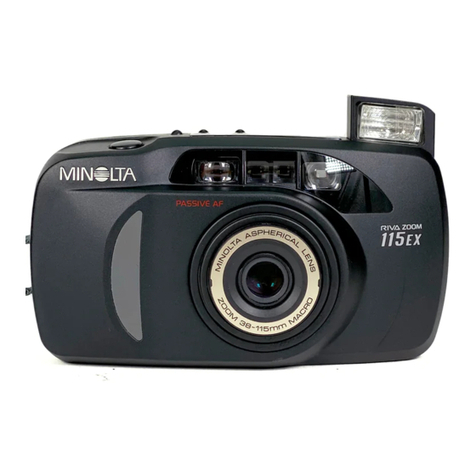
Minolta
Minolta Riva Zoom 115EX instruction manual
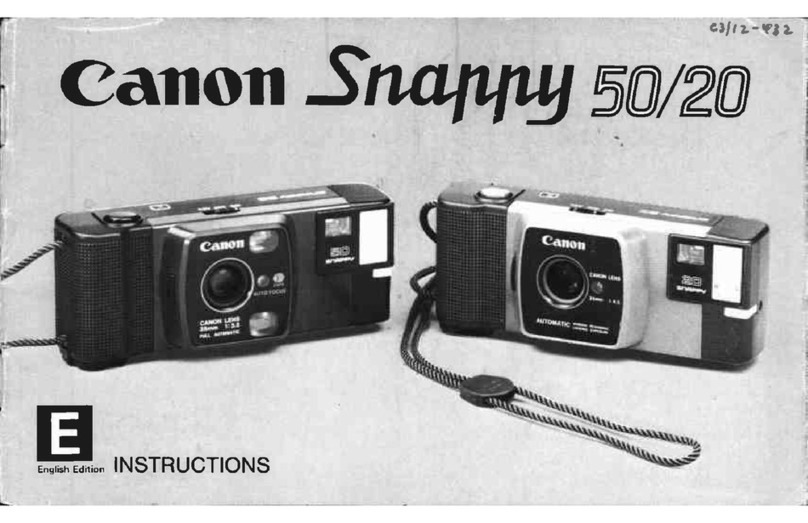
Canon
Canon Snappy 50/20 instructions
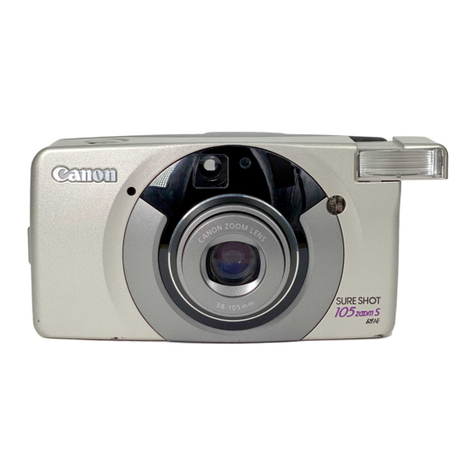
Canon
Canon Sure Shot 105 Zoom - Zoom instructions
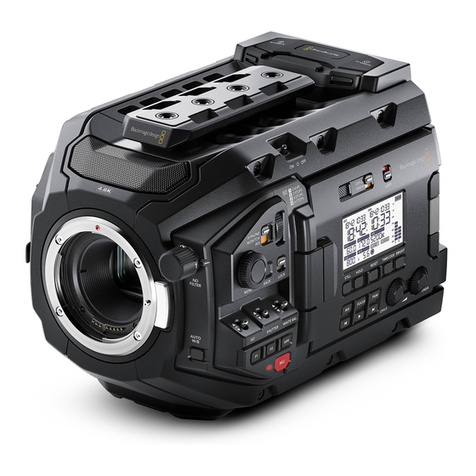
Blackmagicdesign
Blackmagicdesign Blackmagic URSA Mini Installation and operation manual
